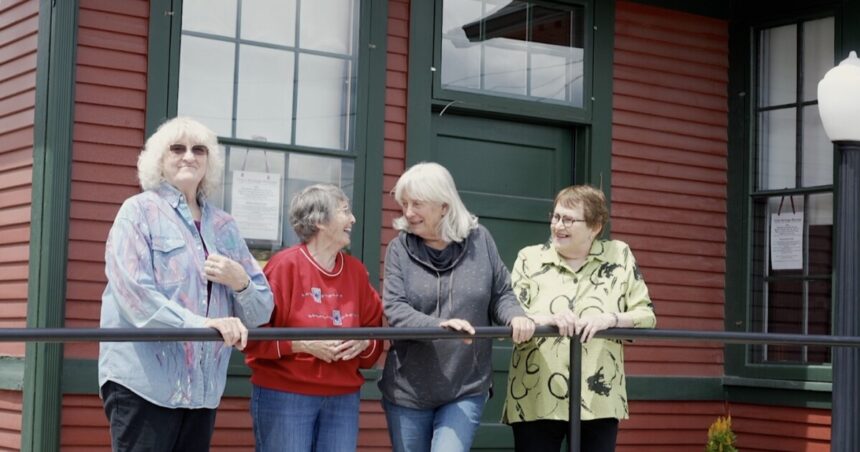VICTOR — To learn about a town’s history, it’s a good start to ask a longtime resident or visit the local museum. In Victor, you can do both.
The Victor Heritage Museum will celebrate its 35th anniversary this fall. The museum sits inside an old railroad depot and is completely run by volunteers.
In September 1989, Peggy Thornbrugh, a Victor resident and postal worker, decided her town needed a museum. So, she gathered a few of her neighbors and got to work.
After a year of bake sales and auctions, they were able to raise $2,000– the necessary funds to transport an old railroad depot from its location near Highway 93 to a plot of land on the corner of Blake and Main Street.
In December of 1990, the building was fully relocated and opened to the public that winter.
One of the people involved with Thornbrugh’s original plan was Joann Hosko, who still works as a volunteer at the museum today.
“I see this museum, the building, the entity, the whole thing, as my baby,” Hosko says. “I’m a native Victor– I was raised here, went through school here, graduated from the school here, and so on… So I’m very attached to the whole– the building, the idea behind the preservation, all of it. It’s just, I can’t imagine not being a part of it.”
Hosko also contributed to the museum by aiding the creation of the Bitterroot Trails Vol. 4.
The book details the history of Victor through the stories of old families, business, community organizations, and churches.
Claire Peterson
Through her passion for the museum, Hosko was able to convince multiple of her own friends to join the volunteer team.
Liz Ingraham went to school with Hosko and started volunteering in 2021.
Displayed in the museum are Victor yearbooks throughout the years, including ones showing Ingraham and Hosko at school together.
“It’s awesome to have people that we grew up with still be our friends,” Ingraham says.
Ingraham has lived in Victor since 1949, and she remembers seeing the first lights show up across the Bitterroot Valley. She hopes that her contribution at the museum will inform younger generations of her own childhood experience.
“Our history is very fascinating, and I think a lot of the young people don’t get a chance to see what it was really like, you know, growing up with no running water in the house, no electricity to start with, you know, and then seeing the progression and the telephones and stuff,” she says. “I think the young people need to see that, need to hear about it.”
Suzanne Tout graduated from Victor School shortly before Hosko, and she joined the Victor Heritage Museum board in 2010 as president.
“I want people to, and especially the young ones, to think about how things change over time, not just that it’s history, but that history is fluid and moves on and on and on,” Tout says.

Claire Peterson
The Victor museum also tells of the influence from Salish People and Chinese American workers.
“I think it’s important to remember that all sorts of people were here and contributed to what is here, and I think what happened with the Salish is very sad,” Tout says. “It makes us appreciate people more, if we know more, when we can think about what they were doing, what they might have thought, how they had to work, how they survived.”
Open only from Memorial Day to Labor Day, the museum has a couple community-wide events throughout the summer.
On July 11 at 6:30 p.m., Bitterroot resident Christopher Weatherly will be presenting about the Blacksmith Shop St. Mary’s Mission.
On Aug. 8 at 6:30 p.m., Bitterroot resident Bruce Gould will present about the “Birth of the Bitterroot Valley.”
There is a community-wide ice cream social on the last Sunday in August.
They also hold a chocolate tasting party in the winter to raise money.
The museum is ran by donations and volunteer work, but they want to see more visitors stop by.
“I just, I wish people knew that it was here and that they would come and visit it more,” Jennie Becker, a museum volunteer says. “It would be nice, I think, if more people were interested in going to old museums and learning more about the areas that they live in.”
Becker didn’t grow up in Victor, but she joined the museum team because she was interested in the history of small Montana towns.
“And I just kind of fell in love with the idea of learning all the old happenings of Victor, you know, who lived here? How was it built? What was it like 100 years ago? You know, just, it’s fascinating to me,” she says.
Now, Becker helps by entering the museum artifacts in a computer filing system.
There are about 10 volunteers that regularly help at the museum, but they are all older adults. Tout hopes young people will be interested in the museum’s volunteer work as well.
“I would just like to see the museum survive and have younger people being able to come in and keep it going,” she says. “I would hate for it to die for lack of. I mean, we’re hanging in here, but at some point in time we won’t be able to.”





